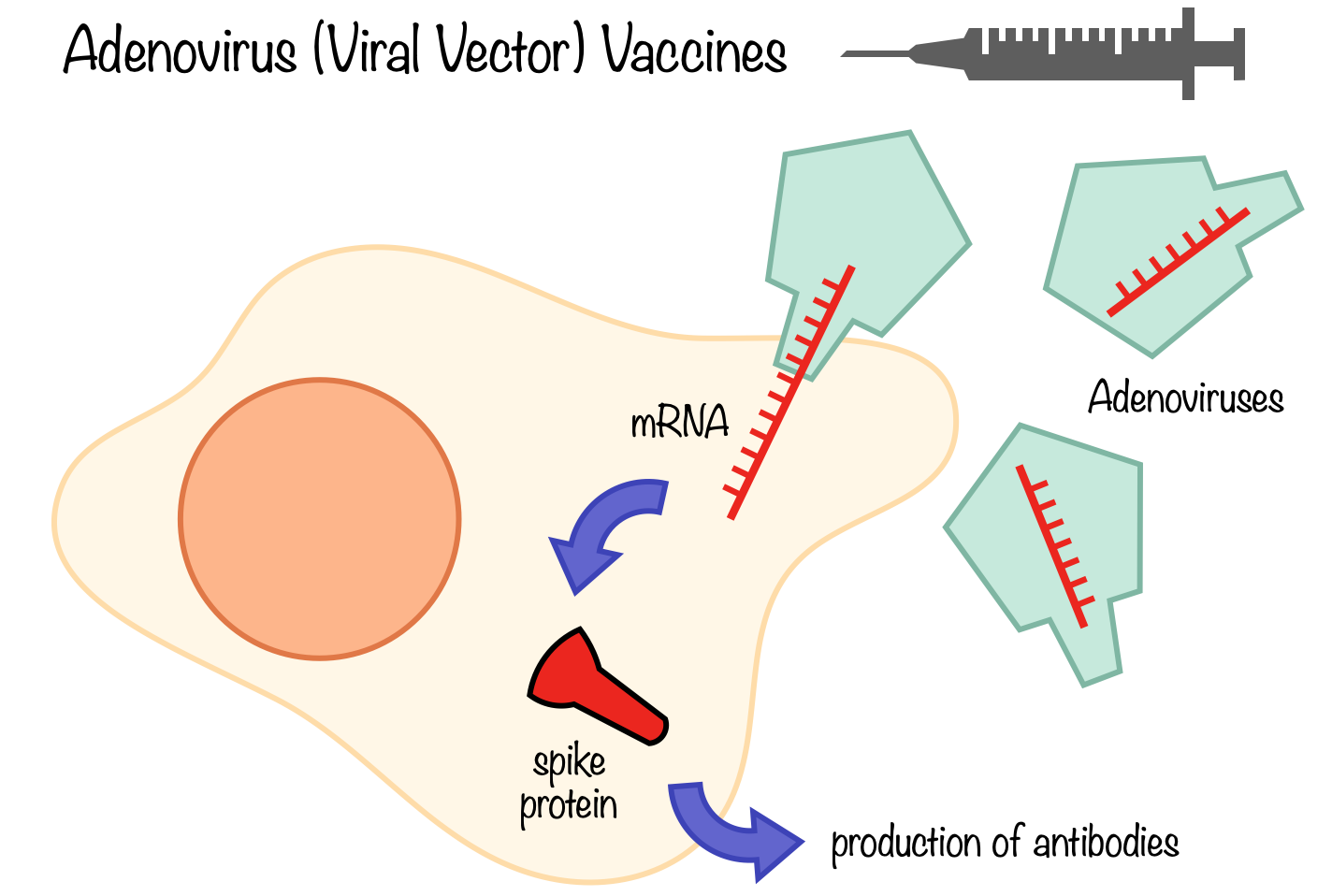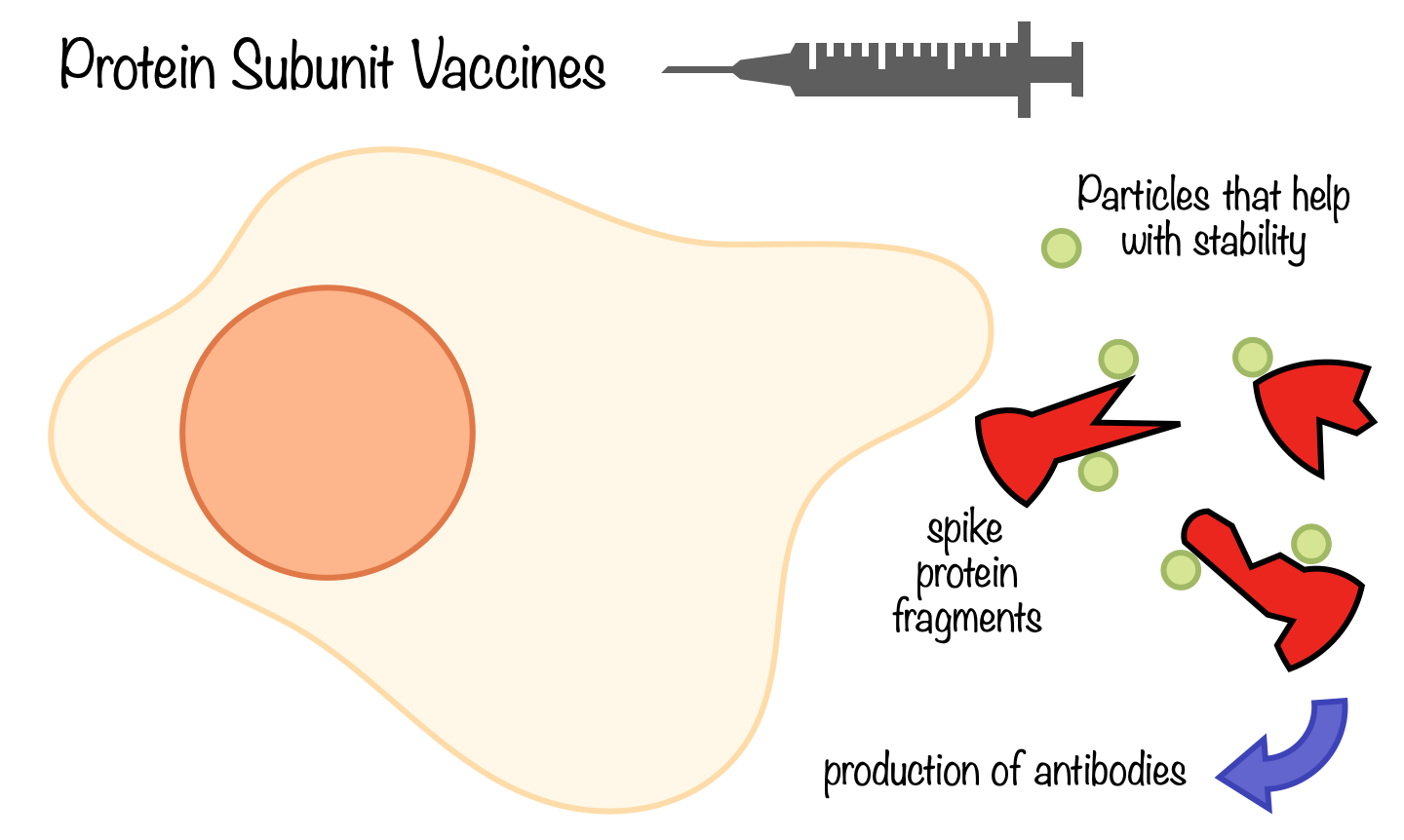VAC-CINE IT ALL BEFORE
COVID VACCINES MINISERIES PART 1: THE NEW AND OLD SCIENCE BEHIND COVID-19 VACCINES
Causing over half a million deaths in the US and nearly 3 million deaths worldwide, the COVID-19 pandemic continues to ravage the world more than a year after its initial detection 1 . Fortunately, there is light at the end of the tunnel as more and more people get vaccinated. With numerous different manufacturers, technologies, dosing schedules, and scary tweets about side effects, it’s easy to be confused about COVID-19 vaccines. This series will break down this information so you can feel at ease when you get your poke.
HOW DO VACCINES WORK?
When you get a cold, virus particles that you breathed in or picked up by touching a surface enter your body, replicating rapidly and destroying your cells. It takes a few days for your body’s immune cells, which are circulating throughout your blood, to recognize the foreign particles, remember what they are, and fight back. First, your white blood cells swallow and break down virus particles into smaller segments, called antigens. Your B-cells then make antibodies, which can recognize these specific antigens. Your T-cells, equipped with these antibodies, can now detect infected cells and destroy them, thus destroying the virus! 2 As a result of these cells doing their jobs, you experience congestion, fever, sore throat, fatigue, and other cold symptoms. So if you’re feeling terrible, know that your immune system is doing its job!
The antibodies produced during this process don’t just go away once you’re feeling better. Your body remembers them so that if you encounter the same virus in the future, it can fight back faster and stronger. Some viruses, like the common cold, have a lot of variants, which is why you can get sick with a cold every winter. But those with fewer variants, like chickenpox, will leave you protected forever after being infected only once.
This is the concept that inspired vaccines. Vaccines mimic your body’s natural immune response, protecting you by “training” your immune cells to fight back against a specific virus. The injection itself contains parts of dead viruses or the information to make parts of viruses. There aren’t enough virus parts to make you sick, but there are enough to cause your immune cells to kick into high gear, making antibodies that they will remember for years. Later, if you happen to come in contact with that particular virus, your body will know how to fight it immediately, and you won’t get sick!
Some people argue that it’s better to get your antibodies the “natural” way, i.e. by getting the actual disease. But this is wrong and harmful in two main ways:
- Not everyone could survive getting the disease. Children, the elderly, and immunocompromised people (such as those with immune disorders or going through chemotherapy) have a significant risk of death from many infections. On the other hand, no one who is medically able to receive a vaccine will die from it.
- Without a vaccine, there is no way to mitigate the spread. This means that the condition can spread rapidly throughout the world, killing millions as in the COVID-19 pandemic. However, if enough people are vaccinated, the population can achieve herd immunity, which protects medically vulnerable people from being exposed and thus, prevents deaths.
So it’s very important to get yourself and your family vaccinated, not only for COVID-19, but for other preventable diseases.
WHAT COVID-19 VACCINES ARE OUT THERE?
In the United States, there are three vaccines approved by the FDA: Pfiser-BioNTech, Moderna, and Johnson & Johnson’s Janssen.3 We’ll get to how they work in a moment, but first, let’s talk about what it means to be “approved.”
The Food and Drug Administration (FDA) is responsible for everything from the nutrition labels you see on food packaging, to the side effects quickly spoken during drug commercials you see on TV, to the approval of vaccines. Drugs and vaccines cannot be legally sold or administered in the US unless they are approved. Furthermore, companies and academic research institutions alike have to conduct three phases of clinical trials before they can even ask for the FDA’s approval. In Phase 1, small groups of healthy people receive a trial version of the vaccine; in Phase 2, a larger group of people, usually reflecting the target demographic, receive it. For example, the target demographic for COVID-19 vaccines includes the elderly and those with pre-existing conditions (and eventually, all adults). In Phase 3, thousands of test subjects are given the vaccine and monitored extensively for side effects.4 The manufacturer submits the data from all three of these trials and the FDA scientists decide if the manufacturing process is safe, if the vaccine can be used, and who it can be used on.5 In an emergency situation, such as the global COVID-19 pandemic, the FDA can issue an Emergency Use Authorization (EUA). If an EUA is requested, the vaccine can be approved before the official end of the Phase 3 trial. However, this does not mean the safety standards are relaxed - it simply means that study subjects have been monitored for slightly less time or there were slightly fewer study subjects than originally planned.6
The Pfizer, Moderna, and Janssen vaccines have all been approved under an EUA, and the FDA is continually monitoring them for safety. There are also two other vaccines, AstraZeneca and Novavax, that are currently being tested in Phase 3 clinical trials in the US.3 While all of these vaccines train your body to respond to the COVID-causing SARS-CoV-2 virus, they work in slightly different ways.
HOW DO COVID-19 VACCINES WORK?
In what is called the “central dogma” of molecular biology, DNA in your cells is used to make mRNA, which is first used to make proteins and then gets degraded. The proteins then perform essential biological functions, like breaking down the food you eat, moving your muscles, or replicating your cells. Viruses also use this to reproduce - when you get infected, the virus replicates its own DNA or RNA inside your cells. The RNA is then used to make the virus’s proteins, and the components are assembled to form the new virus. Vaccines aim to get your body to produce enough of the virus’s proteins that your body will make antibodies against it, allowing it to recognize and fight off that virus in the future.
ADENOVIRUS (VIRAL VECTOR) VACCINES
Adenovirus vaccines have been used since the 1970s. They utilize adenoviruses, which are an extremely common type of virus that cause generic cold-like symptoms. The harmless adenovirus shell is first isolated, then filled with the mRNA encoding information to make the COVID spike protein. The adenoviruses infect your body’s cells, similar to how you’d get a normal infection, and get them to produce COVID spike protein. Your immune cells then make antibodies to recognize this protein, so you’ll be protected from later exposure to the virus. Though it may have slightly lower effectiveness than the other vaccine types, many people feel comfortable with this technology because it mimics the viral infection process and it has been around for many decades.7
The J&J and AstraZeneca Vaccines are adenovirus vaccines.
mRNA VACCINES
Instead of encasing spike protein mRNA in a harmless viral shell, mRNA vaccines inject part of the spike protein mRNA into your body directly. The mRNA is not enclosed in a virus, though it is packaged in a solution that allows immune cells to absorb it more easily. After immune cells take in the mRNA, they produce spike protein fragments, the same way as before, and your body produces antibodies. This type of vaccine is amazingly effective against COVID-19. Contrary to popular belief, these vaccines are not “unknown” or “untested”, and you can see that they are based on a very similar idea to the more traditional adenovirus vaccines.8
The Pfizer and Moderna vaccines are mRNA vaccines.
PROTEIN SUBUNIT VACCINES
While the other two types of vaccines give you the genetic information that allows your body to make spike proteins, this type of vaccine injects portions of the spike protein directly. The manufacturer produces protein fragments in bulk using insect cell cultures, then attaches them to small particles for stability. When you get the vaccine, your body recognizes the protein fragments as foreign and starts producing antibodies right away. These vaccines have also been in use for a long time.9
The NovaVax Vaccine is a protein subunit vaccine.
Next week, we’ll continue this miniseries by discussing vaccine side effects, safety, and efficacy.
REFERENCES
“WHO Coronavirus (COVID-19) Dashboard.” World Health Organization, World Health Organization, 2021, https://covid19.who.int/.
“Understanding How COVID-19 Vaccines Work.” Centers for Disease Control and Prevention, Centers for Disease Control and Prevention, 9 Mar. 2021, www.cdc.gov/coronavirus/2019-ncov/vaccines/different-vaccines/how-they-work.html?CDC_AA_refVal=https%3A%2F%2Fwww.cdc.gov%2Fcoronavirus%2F2019-ncov%2Fvaccines%2Fabout-vaccines%2Fhow-they-work.html.
“Different COVID-19 Vaccines.” Centers for Disease Control and Prevention, Centers for Disease Control and Prevention, 13 Apr. 2021, www.cdc.gov/coronavirus/2019-ncov/vaccines/different-vaccines.html.
“Vaccine Testing and Approval Process.” Centers for Disease Control and Prevention, Centers for Disease Control and Prevention, 1 May 2014, www.cdc.gov/vaccines/basics/test-approve.html.
“Learn More About COVID-19 Vaccines From the FDA.” U.S. Food and Drug Administration, FDA, 13 Apr. 2021, www.fda.gov/consumers/consumer-updates/learn-more-about-covid-19-vaccines-fda.
Center for Biologics Evaluation and Research. “Emergency Use Authorization for Vaccines Explained.” U.S. Food and Drug Administration, FDA, 11 Nov. 2020, www.fda.gov/vaccines-blood-biologics/vaccines/emergency-use-authorization-vaccines-explained.
“Understanding Viral Vector COVID-19 Vaccines.” Centers for Disease Control and Prevention, Centers for Disease Control and Prevention, 13 Apr. 2021, www.cdc.gov/coronavirus/2019-ncov/vaccines/different-vaccines/viralvector.html.
“Understanding MRNA COVID-19 Vaccines.” Centers for Disease Control and Prevention, Centers for Disease Control and Prevention, 4 Mar. 2021, www.cdc.gov/coronavirus/2019-ncov/vaccines/different-vaccines/mrna.html.
Forni, Guido, and Alberto Mantovani. "COVID-19 vaccines: where we stand and challenges ahead." Cell Death & Differentiation 28.2 (2021): 626-639.






